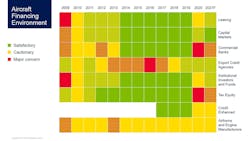Boeing Says Capital is Available for Jet Buyers
Boeing Capital Corp. issued an updated forecast of aircraft- finance markets for the first time since 2019 and concludes that commercial-aircraft customers continue to have access to “global and diversified funding”.
"Financiers and investors understand the industry's resilience and the long-term fundamentals that make aircraft a valuable asset class," stated Tim Myers, president of Boeing Capital. "Despite the unprecedented impacts of COVID-19 on the global aerospace industry, there generally continues to be liquidity in the market for our customers, and we expect it to further improve as travel begins to rebound."
Aircraft orders have plummeted since March 2020, after several years of rising order volumes, as airlines reassessed their own forecasts for passenger volumes and new capacity requirements. Boeing’s 2020 Commercial Market Outlook for aircraft and services -- a separate annual 20-year forecast – currently projects passenger traffic to grow an average 4% annual rate; and foresees the global commercial aircraft fleet rising to 48,400 by 2039 (up from 25,900 aircraft in 2021.)
The pandemic is a separate concern for Boeing, which has been forced simultaneously to revise the order books for its 737 MAX, 777, and 787 Dreamliners series, each affected by different safety and maintenance issues.Boeing’s 2021 Current Aircraft Finance Market Outlook (CAFMO) presents a near-term view of market dynamics and assesses financing sources for new commercial airplane deliveries. The OEM did not include its customary one-year and five-year financing projections in this version of the CAFMO, citing the ongoing impacts of the pandemic.
"Industry fundamentals continue to show varying degrees of strength in different markets depending on the regional trends of the global pandemic," Myers stated. "We expect that capital will continue to be routed into the sector by established players and as new entrants seek opportunities during the industry's recovery."
The 2021 CAFMO reports that the aircraft financing sector ended 2020 with sufficient liquidity to finance deliveries, but with notable “stresses” in the bank-debt and tax-equity markets.
Some highlighted conclusions of Boeing’s 2020 CAFMO include:
- Commercial aircraft delivery funding volume totaled $59 billion in 2020, down -40% from 2019;
- The top sources of Boeing delivery financing were cash, bank debt and capital markets, and 100% of Boeing deliveries were financed by third parties;
- Aircraft lessors executed a significant volume of sale-leaseback transactions, and the industry-wide leased fleet climbed to 46%;
- Capital markets for aviation volumes were 70% higher than in 2019;
- Commercial banks shored up the aviation industry's need for liquidity early in the pandemic, but long-term bank debt became one of the less utilized forms of financing;
- Institutional investors and funds continued to seek aviation exposure, filling in as some other financiers paused, and sector credit spreads widened.

